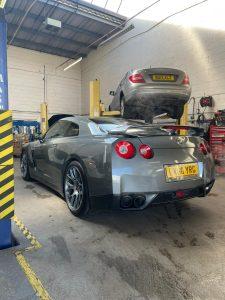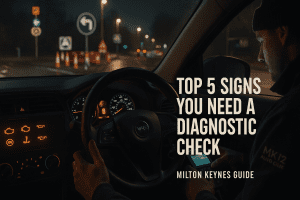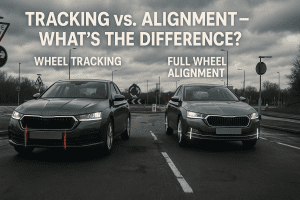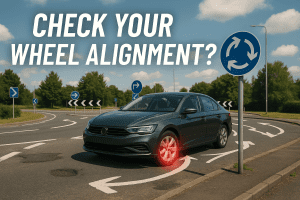
If you own a Class 7 vehicle in the UK/England, the law requires you to have it undergo an MOT (Ministry of Transport) test. The Class 7 MOT Test is a specific type of MOT test designed for larger commercial vehicles. In this blog post, we’ll take a closer look at what Class 7 MOT tests entail, why they are important
and what you can do to ensure that your vehicle passes its test.
What is a Class 7 Vehicle?
Before we dive into the details of the test, it’s important to understand what a Class 7 vehicle is. In the UK, vehicles are classified based on their weight and purpose. Class 7 vehicles are commercial vehicles that weigh between 3,001 and 3,500 kg. These vehicles are typically used for transportation of goods and are larger than Class 4 vehicles, which are cars, vans, and minibuses that weigh up to 3,000 kg.
MOT Test Requirements for Class 7 Vehicles
- Lights and Electrical Equipment: The MOT test inspector checks if the lights, indicators, and other electrical equipment on the vehicle are working correctly.
- Steering and Suspension: The MOT test inspector inspects the vehicle’s steering and suspension system to ensure they are in good condition and safe for use.
- Brakes: The MOT test inspector tests the vehicle’s brakes to check their effectiveness and ensure they meet the legal requirements.
- Tyres and Wheels: The MOT test inspector inspects the tyres and wheels of the vehicle to ensure that they are in good condition and meet the legal requirements.
- Exhaust System: The MOT test inspector checks the exhaust system of the vehicle to ensure it is in good condition and meets the legal requirements for emissions.
- Bodywork: The MOT test inspector inspects the bodywork of the vehicle to ensure that it is in good condition and safe for use.
- Fuel System: The mechanic checks the fuel system of the vehicle to ensure it is in good condition and safe to use.
- Other Miscellaneous Items: The MOT inspector also checks other miscellaneous items, such as the horn, wipers, mirrors, and seat belts.
Differences between Class 4 and 7 MOT Tests
Class 4 MOT tests cover cars, vans, and light vehicles up to 8 seats, while Class 7 MOT tests are for larger commercial vehicles that carry heavier loads. The law requires Class 7 vehicles, such as vans and pickups weighing between 3,000 and 3,500 kg, to undergo an MOT test every year once they exceed three years of age.
If a Class 7 vehicle fails the MOT test, it must undergo necessary repairs and pass a retest before it can be legally driven again. Therefore, it is important to take the MOT test seriously to ensure that the vehicle meets safety and environmental standards MOT inspectors conduct thorough checks on various aspects of the vehicle, such as suspension, brakes, steering, and emissions, and also examine the seats, seat belts, and doors.
Certain Class 7 vehicles may require a different type of MOT test based on their use. Taking the MOT test seriously is essential to ensure that the vehicle meets safety and environmental standards. The cost of a Class 7 MOT test is also generally higher than a Class 4 MOT test. This is because the inspection is more thorough, and the equipment required for the test is often more expensive due to the larger size and weight of the vehicle.
When is a MOT Class 7 Required?
As the owner of a Class 7 commercial vehicle in the UK, you must arrange for an MOT (Ministry of Transport) test annually once it is over three years old. This test applies to vehicles weighing between 3,000 and 3,500 kg, including large vans and pickups. However, if your Class 7 vehicle transports hazardous goods, it may require a different type of MOT test. It’s vital to verify the correct test type with your MOT test center. If your Class 7 vehicle fails the MOT test, you must not drive it on public roads until you’ve completed the required repairs and passed a retest. Noncompliance may result in substantial fines and penalty points on your driving license. Therefore, it’s crucial to take your Class 7 vehicle’s MOT test seriously to ensure that it meets the essential safety and environmental standards.
What Happens During Test in 7 Class MOT ?
During a test, an MOT inspector will thoroughly examine your vehicle to ensure that it meets the legal requirements for safety and emissions. The test includes a series of checks on various parts of the vehicle, including the brakes, suspension, steering, tires, lights, and emissions. One of the key checks during a MOT test is the emissions test. The MOT inspector will check the emissions from the vehicle to ensure that they meet the legal requirements. If the emissions are too high, the vehicle will fail the MOT test.
Another important check during MOT test is the inspection of the vehicle’s brakes. The inspector will check the condition of the brake pads, discs, and calipers to ensure that they are in good working condition. Additionally, the braking system’s efficiency will be tested to ensure that it meets the legal requirements.
Other aspects of the vehicle that are inspected during a test include the vehicle’s suspension, steering, and tires. The inspector will check the condition of these components to ensure that they are in good working order and meet the legal requirements.
In conclusion, a Class 7 MOT test is a necessary requirement for commercial vehicles in the UK/England. It is essential to understand the differences between Class 4 and 7 MOT tests, the requirements for a test, and what happens during the test to ensure that your vehicle passes with flying colors. By following the tips for preparing for the test, you can ensure that your vehicle is in good condition
How to Prepare for a 7 MOT Test
Preparing for a Class 7 MOT tests can help ensure that your vehicle passes with flying colors. Here are a few tips:
- Perform regular maintenance: Regular maintenance, such as oil changes and tire rotations, can help keep your vehicle in good condition and reduce the likelihood of failures during the MOT test.
- Check your lights and indicators: Make sure that all of your lights and indicators are working properly before the test.
- Check your brakes: Make sure that your brakes are in good condition and that they meet the legal requirements.
- Check your tires: Make sure that your tires have enough tread and are in good condition.
- Clean your vehicle: A clean vehicle can make it easier for the inspector to see any issues during the test.
- Choose the right test center: To ensure your vehicle undergoes a fair and accurate test, it’s important to choose an MOT test center with experienced inspectors and a good reputation.
Conclusion
In conclusion, the Class 7 MOT test is an important requirement for owners of commercial vehicles in the UK/England. It ensures that these larger vehicles meet the legal requirements for safety and emissions, and helps keep our roads safe for everyone. By understanding the requirements of the test, preparing your vehicle properly, and choosing the right test center, you can help ensure that your vehicle passes its test with flying colors. So, if you own a Class 7 vehicle, don’t forget to schedule your MOT test and keep your vehicle in good condition!. If you want to MOT Test Milton Keynes – then you can go MK12 Autocare Ltd. They are execellent.






